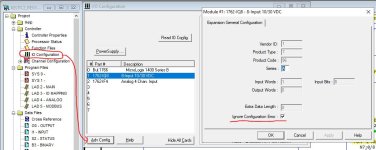Hi.
I have a legacy project with an SLC500 PLC (SLC5/04 CPU), and we want to connect a data logging system to it.
Management want to make a test offsite before implementing it onsite.
I am a bit rusty, since it is approx. 20 years since I worked with AB SLC500.
We do have SLC5/04 CPUs, Racks and power supplies, but we do not have the exact IO modules.
Correct me if I am wrong, but I think that it is possible to simulate the program in the CPU. For the slots in the rack that are not fitted with the correct IO module you have to disable said slots so that the CPU doesn't fault on hardware error.
I have looked into the system file, and I think that S:11 and S:12 can be used for this purpose. Do I simply set all the bits to TRUE and set the CPU to RUN ?
Anything else to be aware of ?
I have a legacy project with an SLC500 PLC (SLC5/04 CPU), and we want to connect a data logging system to it.
Management want to make a test offsite before implementing it onsite.
I am a bit rusty, since it is approx. 20 years since I worked with AB SLC500.
We do have SLC5/04 CPUs, Racks and power supplies, but we do not have the exact IO modules.
Correct me if I am wrong, but I think that it is possible to simulate the program in the CPU. For the slots in the rack that are not fitted with the correct IO module you have to disable said slots so that the CPU doesn't fault on hardware error.
I have looked into the system file, and I think that S:11 and S:12 can be used for this purpose. Do I simply set all the bits to TRUE and set the CPU to RUN ?
Anything else to be aware of ?
Last edited:






